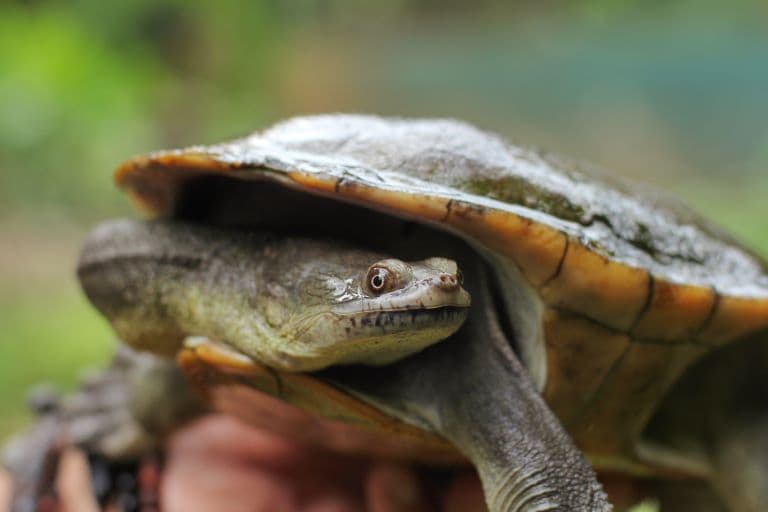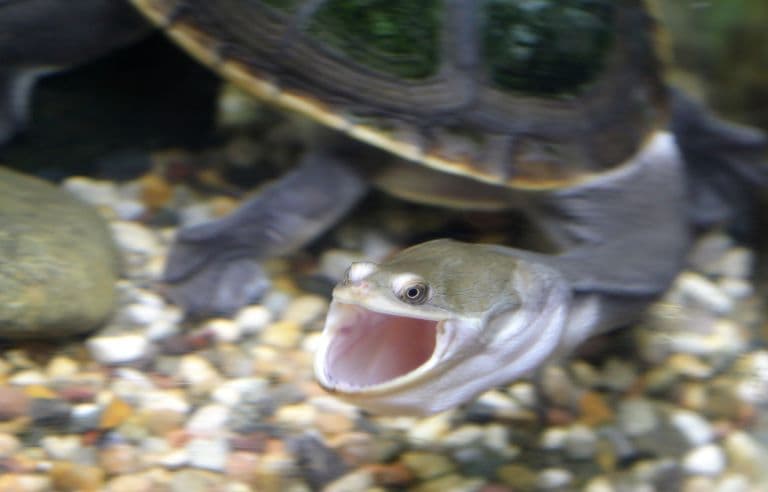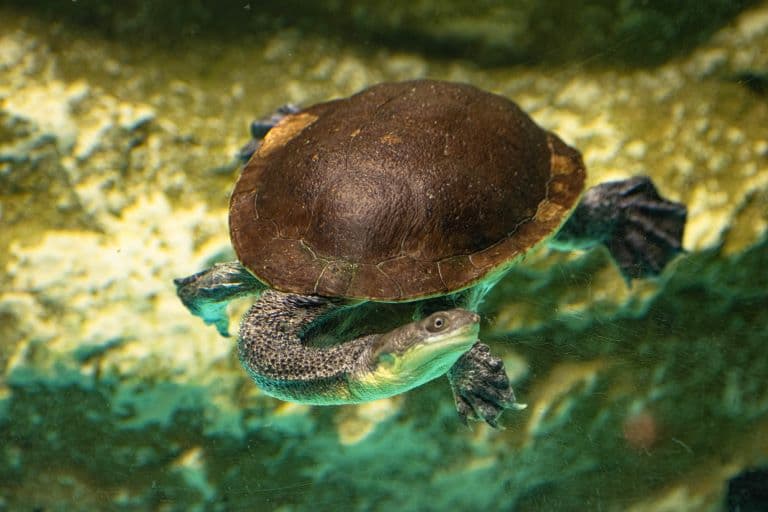Snake-Necked Turtle Profile
The first ancestors of modern turtles lived around 260 million years ago, roughly around the time dinosaurs began their dominance over the planet. Since then, they’ve done relatively well for themselves, evolving shells and retractable appendages and surviving with little adjustments, through multiple extinction events.
There are over 300 species in the order, split between the most common tortoises and turtles in the Cryptodira suborder, and the unique branch of Pleurodira turtles, whose necks are so long, that they need to be folded for protection.
Within this group, are the snake-necked turtle. A curious family of Pleurodira turtles with smiling little faces and a nasty nip.

Snake-Necked Turtles Facts Overview
| Habitat: | Aquatic, terrestrial |
| Location: | Australia, New Guinea, Indonesia, South America |
| Lifespan: | 30 years or more |
| Size: | 16 – 50cm (6 – 20 inches) |
| Weight: | Up to 4kg (9lb) |
| Colour: | Grey to yellow-green |
| Diet: | Fish, arthropods, gastropods, some are herbivorous |
| Predators: | Foxes, dogs, crocodiles, |
| Top Speed: | Unknown |
| No. of Species: | Around 40 |
| Conservation Status: | Least Concern to Critically Endangered (IUCN) |
Snake-necked turtles are a family of side-necked turtles, known for their efficient and lightening-fast ambush hunting style.
But they aren’t all predators, some prefer grasses and algae, and will only eat meat if there’s nothing left. Others are more fussy and will scrap over the last fish.
These turtles cut their teeth on an ancient supercontinent and have separated from one another with the tectonic motion of the continental plates.
Today there are many species, a worrying percentage of which are desperately threatened with extinction.
Interesting Snake-Necked Turtles Facts
1. Gondwana turtles
When looking at a globe, it can be surprising to see just how close South America is to Antarctica. But a mere 200 million years ago it was substantially closer. Gondwana was a supercontinent and a 100,000,000 km2 landmass that included Africa, Arabia, Australia, Antarctica, New Zealand, South America and India in one big smush of conjoined continents.
Over time, as we can see by their positions now, these chunks broke off from the main body of Gondwana and separated from each other. South America only recently joined North America, somewhere around 2.5 million years ago, and was until then an isolated island continent.
This is how fossils of some species, like kangaroos and the monotreme, are dug up in South America, despite only existing in Australia today. In fact, many of the classic marsupials found in Australia – the kangaroos, wallabies, and wombats – originated in what is now South America.
Snake-necked turtles would have once occupied Antarctica as part of Gondwana, and while those populations don’t survive, modern species endured the ride through the ocean on the South American island, and continue to this day, once part of a diverse range of species connected by land, now separated by 15,000km of ocean. 1

2. They can’t retract their necks
Snake-necked turtles have bizarrely long necks, which is of course why they’re named the way they are. Because these necks are sometimes longer than their shell, there’s nowhere to keep them when defending themselves, so instead, they’re pulled around into a sort of S-shape and held perpendicular to the body for protection.
This has given the suborder of these turtles the name, “side-necked turtles”, of which the family of snake-necked turtles is one.
Many of these turtles are omnivorous, taking any opportunity to feed on whatever’s around, but some are purely carnivorous, feeding primarily on fish, and the most adept hunters use this neck as part of their feeding mechanism. 2

3. They’re Suckers
All snake-necked turtles enjoy the water, and most are almost exclusively aquatic, choosing to walk across the bottom of water bodies, rather than swim.
Those who feed on fish will stalk prey with their necks folded back, which hides their reach from unsuspecting fish.
This allows the turtle to get closer than the fish should be comfortable with, without heightening their anxiety, before the predator lunges forward and opens its mouth, causing suction to draw the prey into the jaws.
This process can happen in as little as 0.004 seconds. The skull shape of the turtle is specially evolved for this striking method, with a flat cranium and well-developed, stretchy oesophagus allowing both speed and power that’s unique to these turtles. 3
4. They can eat anything
The long neck gives them a surprising range and is an extremely effective predatory adaptation, but across the numerous species of snake-necked turtles, there is a diverse set of diets.
Most will eat both plant and animal matter, some will eat only fish, and a handful are entirely herbivorous. One species is specialised for fruits, which very rarely needs ambush strategies to acquire.
Snake-necked turtles are said to be very fond of food in general, and captive specimens can easily become obese. 4 5

5. Some are more adaptable than others
Of the omnivorous species, some are highly adaptable when it comes to diet, and many species in this family alter their behaviour in response to environmental conditions.
The Macquarie River turtle exhibits optimal foraging strategies, in which it will show a strong preference for a particular food, but when that item is scarce, adapts to a different strategy to survive. While this species mostly feeds on green algae, they will switch to carnivorous diets when there is no such food.
Still, they don’t appear to enjoy this and will lose appetite, showing that it’s not an ideal switch. Other species will simply refuse to eat their vegetables and will instead fight each other when their source of meat runs low.
The Western swamp tortoise is a rare snake-necked turtle found in Western Australia and survives times of drought by spending 6-9 months just hiding in holes in the ground. During this time, they barely eat.
6. Many are seriously threatened
Of the 40+ species of snake-necked turtle species, a worrying number are pushed toward extinction. Most of the causes are unrelated to human consumption, but as with most threatened species, humans are the strongest factor at play, one way or another.
Habitat conversion has wiped out much of the viable space for the Roti snake-necked turtle, and the pet trade has compounded their decline with illegal collections. Deforestation and climate change have degraded their wetland habitats, and the species is now critically endangered.
Invasive species like pigs, dogs and cats finished off the species on its native island of Roti, and they are now considered ecologically and economically extinct there.

Snake-Necked Turtles Fact-File Summary
Scientific Classification
| Kingdom: | Animalia |
| Phylum: | Chordata |
| Class: | Reptilia |
| Order: | Testudines |
| Family: | Chelidae |
Fact Sources & References
- Ignacio J. Maniel (2016), “A Review of the Fossil Record of Turtles of the Clade Pan-Chelidae”, BioOne Digital Library.
- cephaschannel (2013), “20140325 蛇頸龜 Chelidae”, YouTube.
- “snake-necked turtle”, Britannica.
- Patrick Lemell (2002), “Feeding patterns of Chelus fimbriatus (Pleurodira:Chelidae)”, Journal of Experimental Biology.
- Russ Gurley (2011), “Snake-Necked Turtle Breeding”, Reptiles.
